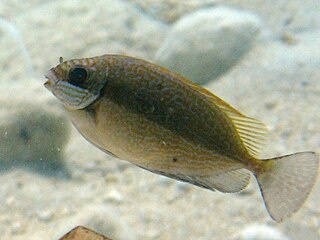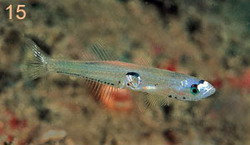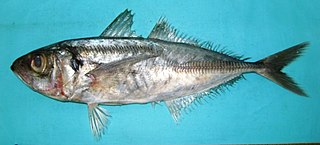
The sergeant major or píntano is a species of damselfish. It grows to a maximum length of about 22.9 centimetres (9.0 in).

The sand goby, also known as a polewig or pollybait, is a species of ray-finned fish native to marine and brackish European waters from the Baltic Sea through the Mediterranean Sea and into the Black Sea where it occurs in sandy or muddy areas of inshore waters at depths of from 4 to 200 metres. This species can reach a length of 11 centimetres (4.3 in) TL. This species is sometimes kept in public aquariums. The sand goby is of a sandy colour, with darker markings on the sides and a creamy-white underside. In the breeding season the male fish has blue spot at the rear of the first dorsal fin, ringed with white. The fish has a slender body, and the head is about a quarter of the total length.

The Red Sea bannerfish is a species of marine ray-finned fish, a butterflyfish from the family Chaetodontidae. It is found in the western Indian Ocean. It has been recorded as an introduced species off Florida and as a Lessepsian migrant in the eastern Mediterranean Sea off Turkey.
Silhouettea is a genus of gobies native to the Indian Ocean and the western Pacific Ocean. The name of this genus refers to the island of Silhouette in the Seychelles where the type specimens of the type species, Silhouettea insinuans, were collected.

The rock goby is a small coastal goby of eastern Atlantic waters, from Scotland to Senegal. It is also reported from the Mediterranean and Black Seas, and is an anti-Lessepsian migrant in the Gulf of Eilat and Red Sea. There are unconfirmed records from the area around Pointe Noire in Congo-Brazzaville.

Tetrosomus gibbosus, commonly called camel cowfish because of the hump on its dorsal keel, is one of 22 species in the boxfish family, Ostraciidae. It is a ray finned fish. Other common names include helmet cowfish, humpback turretfish and thornbacked boxfish. It is most closely related to T. reipublicae, the smallspine turretfish. T. gibbosus is a species of boxfish found in the wide Indo-West Pacific. It has been recorded since 1988 on rare occasions in the Levantine waters of the Mediterranean Sea, likely following entry via the Suez Canal. It is the first species from the family Ostraciidae to be found in the Mediterranean Sea.

The Indian mackerel is a species of mackerel in the scombrid family of order Perciformes. It is commonly found in the Indian and West Pacific oceans, and their surrounding seas. It is an important food fish and is commonly used in South and South-East Asian cuisine.

The chameleon goby is a species of ray-finned fish native to marine and brackish waters along the coasts of eastern Asia. It has also spread to other parts of the world where it is found in waters with varying degrees of salinity.

The dusky spinefoot, also known the squaretail rabbitfish,is a species of marine ray-finned fish, a rabbitfish belonging to the family Siganidae. It is native to the western Indian Ocean which has spread to the Mediterranean Sea through the Suez Canal. Its fin spines contain venom. It is regarded as a food fish.

Crystallogobius linearis, the crystal goby, is a species of goby native to the Atlantic coasts of Europe and the Mediterranean Sea where it can be found at depths of from 1 to 400 metres. Males of this species grow to a length of 4.7 centimetres (1.9 in) SL while females only reach 3.9 centimetres (1.5 in) SL. This species is the only known member of its genus. The name Crystallogobius comes from the Latin words cristallum, meaning "crystal", and gobius, meaning gudgeon.

The largetooth goby, also known as Wilbur's goby, is a species of ray-finned fish from the family Gobiidae which is native to the Indo-Pacific from the Seychelles to Micronesia. Its known range has been extended to the Red Sea as specimens were photographed at one site and collected at another site off Egypt. This species lives in sheltered marine waters at depths of from 0 to 20 metres preferring areas with sandy substrates. This species grows to a length of 6.5 centimetres (2.6 in) SL. This species is the only known member of its genus. This species is not obviously sexually dimorphic and it has a background colour of pale brown to greenish-brown and a pale ventral side. The body is marked with brown and white spots, pairs of larger brown spots create a mid-lateral row along its flanks and there is a dark spot on the caudal fin peduncle. It has a brown blotch on the cheek and a series of short brown bars along its back. The largetooth goby is a solitary fish which is found in coastal bays, lagoons and estuaries over fine sandy substrates close to the margins of reefs or silt beds in the vicinity of sheltered and often turbid coastal reefs. It is most frequently collected from shallow waters to 7 metres (23 ft), around coral reefs but off southern Japan, the largetooth goby occurs at the bottom of sandy bays. The specific name honours the American physician, Ray Lyman Wilbur (1875–1949) who was president of Stanford University from 1916–1943, as well as being the United States Secretary of the Interior from 1929–1933. Wilbur helped the author, Herre, get to Palau, the type locality of this species.

Pelates quadrilineatus, also known as the trumpeter perch or fourlined terapon, is a species of ray-finned fish in the family Terapontidae, the grunters. It occurs in the western Indo-Pacific region, and also in the eastern Mediterranean Sea, having arrived there by passing through the Suez Canal.

Vanderhorstia mertensi, Mertens' shrimp goby or the slender shrimp goby, is a ray-finned fish species native to the Red Sea, Japan, Papua-New Guinea and the Great Barrier Reef. Male individuals can reach a length of 11 cm in total. In 2008 a first specimen was collected in the Mediterranean Sea, in the Gulf of Fethiye, southern Turkey, where it was found on sandy bottoms in the vicinity of beds of sea grass. It is now common in Israel, Turkey and Greece. According to the Mediterranean Science Commission this species most likely entered the Mediterranean via the Suez Canal from the Red Sea.
The specific name honours the German herpetologist Robert Mertens (1894-1975), the former director of the Naturmuseum Senckenberg in Frankfurt, from whom the author, Klausewitz, learnt about the biological and ecological view of modern systematics and taxonomy.

Stephanolepis diaspros, commonly known as the reticulated filefish or the reticulated leatherjacket, is a species of bony fish, a ray-finned fish in the family Monacanthidae. Its natural range is the western Indian Ocean but it is also one of the species which has colonised the Mediterranean through the Suez Canal by Lessepsian migration from the Red Sea.
Cynoglossus sinusarabici, the Red Sea tonguesole, is a species of tonguefish which occurs in the Red Sea and is now common in the eastern Mediterranean Sea following its migration through the Suez Canal. It was first recorded in the Mediterranean Sea off Israel in 1953 and successively observed in Turkey and Egypt. It has an elongated body with a rounded snout which has a rostral hook large, narrowly separated eyes. It has 99–101 dorsal fin rays, 78–79 rays in its anal fin and 8 rays in the caudal fin. The lateral line has 54–60 scales with 11 scales between the lateral line and the base of the dorsal fin. The lateral line is only present on the eyed side. It is uniform brown on the eyed side and whitish on the blind side. It grows to about 15 cm standard length.
Coryogalops ocheticus is a species of ray-finned fish from the family Gobiidae from the Red Sea. It has been reported twice in the Mediterranean Sea off Egypt in 1924 and 1969, but not since. It is found in shallow water, in the proximity of crevices and holes, on sand and mud flats, where there is algal growth, and in stony areas. It attains a total length of 6.2 centimetres (2.4 in). In preserved specimens it is pale fawn in colour and is marked with lateral blotches and mottling on the cheeks.
Oxyurichthys petersii, commonly known as Peters' goby, is a species of ray-finned fish, a goby, from the family Oxudercidae. It is native to the Red Sea, and has now colonised the eastern Mediterranean Sea by Lessepsian migration through the Suez Canal.

The Arabian scad is a species of jack mackerel from the family Carangidae which is found in the Western Indian Ocean.
Pteragogus trispilus is a species of marine ray-finned fish from the wrasse family, the Labridae. It is native to the Red Sea from where it has entered the Mediterranean Sea.

Upeneus pori is a species of marine ray-finned fish, a goatfish from the family Mullidae which is found in western Indian Ocean and the eastern Mediterranean Sea.














